Way back in 2011, we broke character and busted a whole case of 2011 Bowman Draft. I say broke character because both Jon and I aren’t particularly fans of anything in the Bowman world. But, to be fair, we’ve busted very little of it so we thought we’d break a case of it and see how we felt. On a business side, we figured we could flip the contents for a good 80% of what we paid so it seemed a reasonable risk to take for some fun color refractor pullin’. We even did a video for it but we didn’t have time to do our normal fanfare with pictures and stuff.
Well, now I’ve got the time and you’re gonna get my review whether you like it or not!
Main Set
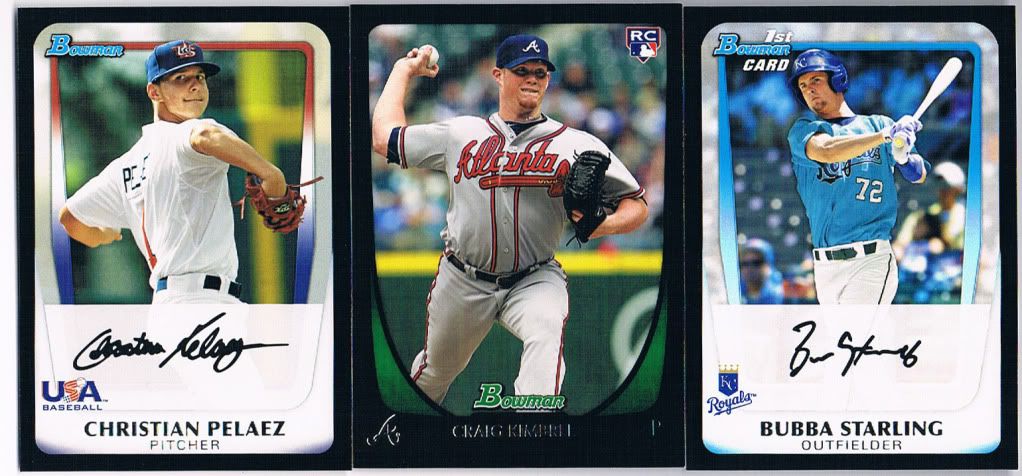
The many flavors of base Bowman Draft.
Before opening this case of Bowman Draft, if you would have asked me what the differences between these cards are, I would have just ignored you. Not only did I not know, I didn’t care and I hope it all goes away. The only thing that would change about that answer now, having touched many of these cards with my actual hands, is that I can tell you what these are. It’s really not that confusing, it’s just unnecessary and stupid. So here is a quick little guide to Bowman.
Craig Kimbrel up there is a Major League rookie, having played in his first MLB game before this set was released. That’s why he gets to be on a Major League Baseball card. He’s got a green highlight. That’s a base card. They are assigned a base number #1-110 just like any other Topps set. Okay, simple enough.
Now, because of the rules the MLB put in place in 2006 to help confused collectors determine what a real rookie card is, a player who hasn’t played in a Major League game can’t have a card in a Major League set. That’s why Bubba Starling (a 2011 draft pick) couldn’t possibly appear in 2011 Topps. In fact, the only reason he can appear in this here Bowman set is because when Topps bought Bowman out, through some draconian legal loophole (or shrewd under-the-table dealings with MLB), they were “grandfathered” into some clause that says a non-MLB player could indeed appear in a set with other Major League players if (and only if) there were cordoned off in an insert set with a different numbering system than the actual set. Which is why Bubba and his brethren get a hilariously complicated BDPP prefix to their card number. They’re numbered #BDPP1-BDPP90. The USA cards are new, but they’re the same deal. You can put anyone you want on a card as long as they’ve got a different number. They’re numbered #BDPP91-BDPP110. Actually, due to an error, BDPP89 and BDPP91 were swapped but blah blah I’m boring myself. Anyway, they’re all technically inserts.
The point is, The Hobby’s hunger for getting The First Card Of A Player was so strong that we’re now getting cards of 16 year-olds in packs. If you ask me (and, even though no one ever has, I have complained about it many times on this blog and others), the inclusion of players who have never played a Major League game do not belong in packs of cards with players who have. Period. Bubba Starling is a top prospect in an organization that I actively collect. And I don’t want to see a card of him until he suits up and steps to the plate at Kauffman. Once he does, I want his cards. Until then, I couldn’t care less. To me, this is the single biggest problem with The Hobby right now. Make as many Minor League sets as you want, Topps. Bubba belongs there, not here.
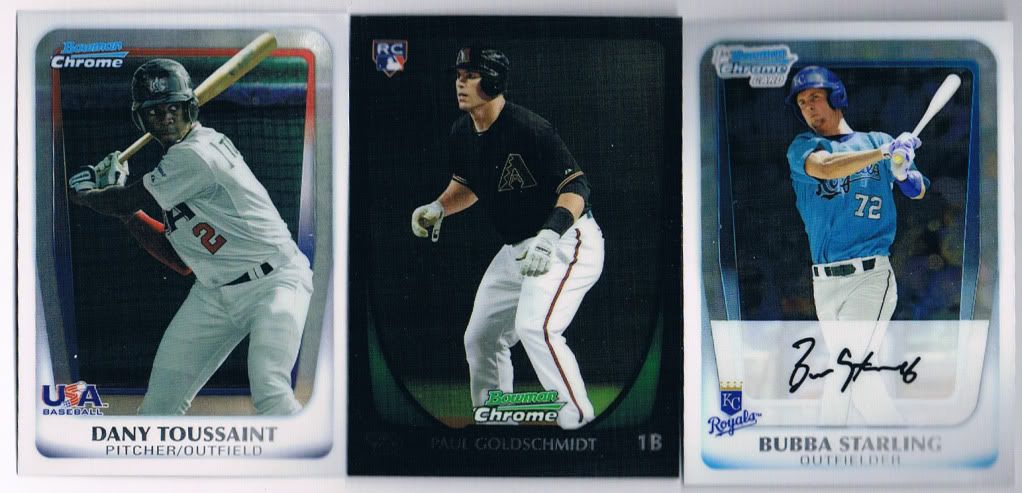
Turtles upon turtles until we're all shell shocked.
Anyway, I’m getting off track. The point is, it’s really not that complicated to figure out the structure of BDPP. It’s complicated by the fact that there each of those card has a chrome companion with its whole cadre of refractors and color refractors. As you might expect, virtually no one cares about the base cards (or their blue-bordered, numbered parallels for that matter). The only reason this set exists is for chrome. Many other bloggers have suggested ditching the base cards in this product entirely and I can’t help but agree. We made 5 complete sets and they sold for under $10. Translation: no interest in the base. All of this is, of course, doubly complicated by the fact that Topps releases 3 different Bowman sets throughout the year and there is overlap between them. Oh, and the past two years they’ve taken to shoving random cards of top Nationals prospects in all of them just for fun. Gah! Focus!
Overall, I like the look of this year’s Bowman design. Bowman has something of a design legacy and this one shares similarities with the very popular 1955 Bowman TV Set set. Of course, these are all vertically oriented but I think you’ll agree they took a cue from the old design. It’s simple and neat- and I love the white borders, personally. The chrome cards look especially nice. A little bowing but not as bad as last year. We did have to ditch about 20 base cards with peeled-up corners. Probably cost us a set but, again, nobody cared.
Parallels and Inserts

Blue is better.
Mercifully, other than the requisite insert set to hold the prospects and USA cards, there are no silly insert sets rehashing the same rookies and prospects. I say mercifully because Topps Finest went apeballs on those this year and it annoyed me. Nope, in Draft, you are spared such frivolity in favor of the candy-colored beauty of refractors. And when I think refractors I think blue. Because they’re the best looking refractors. Especially for the Royals, Dodgers and Rays and sometimes the Blue Jays when the stars align. Anyway, we got the expected amount of color, including the Brandon Gomes above and the Michael McKenry red below.
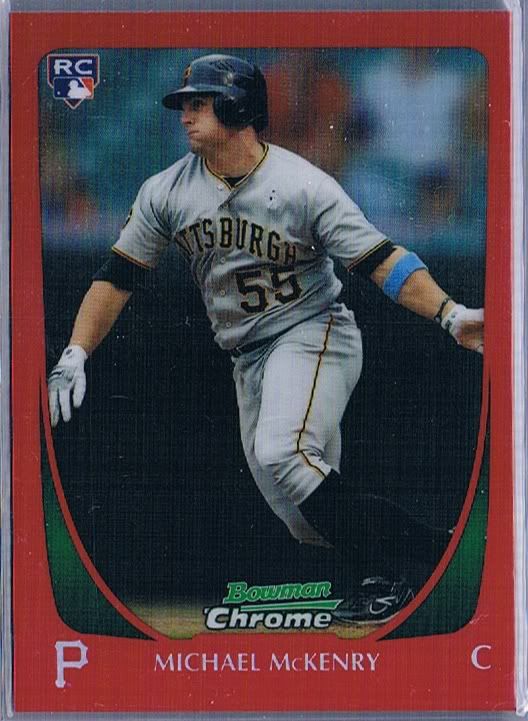
Mikey #/5 is alive!
The color scheme for Bowman Chrome is less complicated than, say, Finest. It’s base, chrome, refractors (unnumbered), blue (#/199), gold (#/50), orange (#/25), red (#/5), and of course the superfractors and printing plates wit the addition of canary diamond 1/1 as well. Each box brought us at least one bit of color. Obviously, the majority of color was blue, but we did get the red and a gold of Kevin Mathews of the Rangers. Then, of course, we pulled this beauty:
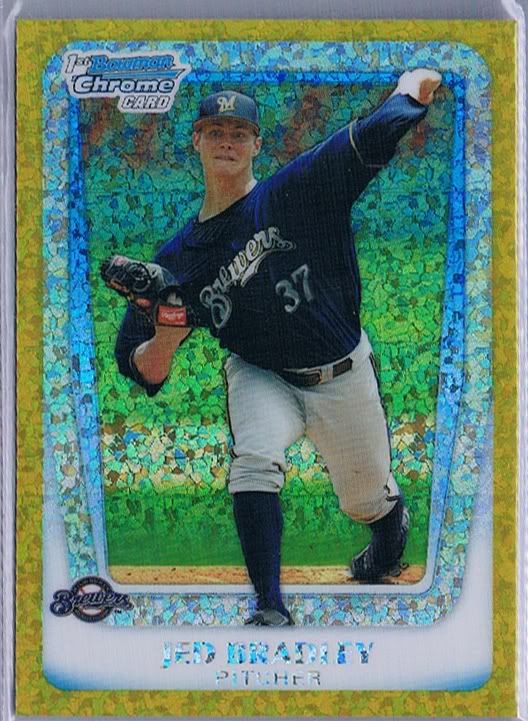
On Golden Shiny.
That’s what the canary diamonds look like. Truthfully, I like the look of them better than the superfractors. But I have to kind of hate them on principal. Five 1/1s for each player is plenty. Oh, and then there are the autographed versions of all of those too. Pretty lame. I’d rather they stick with the single 1/1 to enhance the chase, but I’m a non-factor in that chase so I guess I probably don’t get a vote. My complaints about these parallels is consistency. Gone are the purple refractors that were retail exclusives last year (though they exist as #/10 prospect autographs this year). I don’t really miss them in and of themselves, I just want each year to be like the last. Not because I hate change (or even that I love consistency)but for the sake of collectors’ ability to follow along from year to year. 10 years from now, we’ll all be saying, “What year of Bowman Draft had those purple parallels? I liked/didn’t like those.” I’m just suggesting that Topps pick a pattern and stick with it so collectors can really become connected to the format. That’s how Bowman Chrome and A&G and Heritage got their fan bases to begin with and I think they risk losing that when they forfeit consistency.
Hits
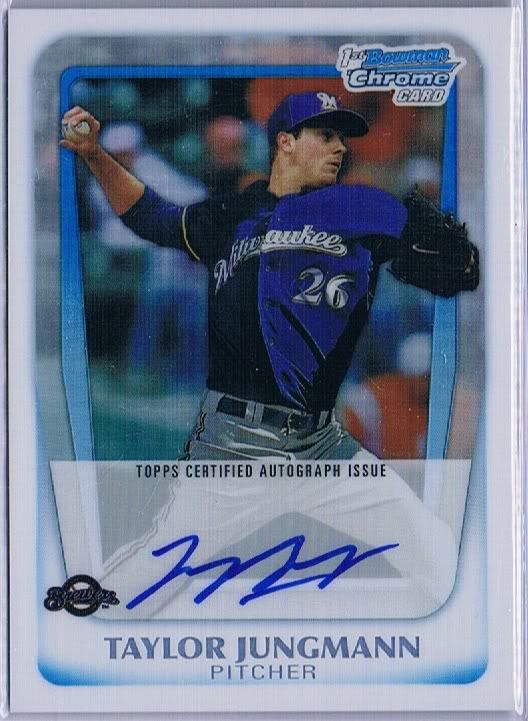
I was about to stretch real hard for a Freud vs. Jung joke. I am glad I didn't. I hope my mom is, too.
And then there are autos. The Taylor Jungmann above is a refractor #/500. As expected, we pulled one auto per box- about half were parallels, including a Trevor Story blue #/150 that is in a package for hiflew from Cards from the Quarry as we speak so it cannot be scanned. While I object to the very existence of prospect autos in Major League products, it is impossible to deny that a well-designed chrome refractor autograph is one of the best-looking cards in the biz. Year in and year out, the Bowman Chrome autos look just like an autograph should. On-card, perfectly formatted… I love these cards despite myselfand it is always a thrill to pull one. Value-wise, some of them don’t stack up- in fact, most of the base autos can be had for a song. The Jungmann refractor there sells for about $15 on eBay. If I didn’t hate them on principal, I’d put a base set together just to see them all next each other. Really nice-looking cards.
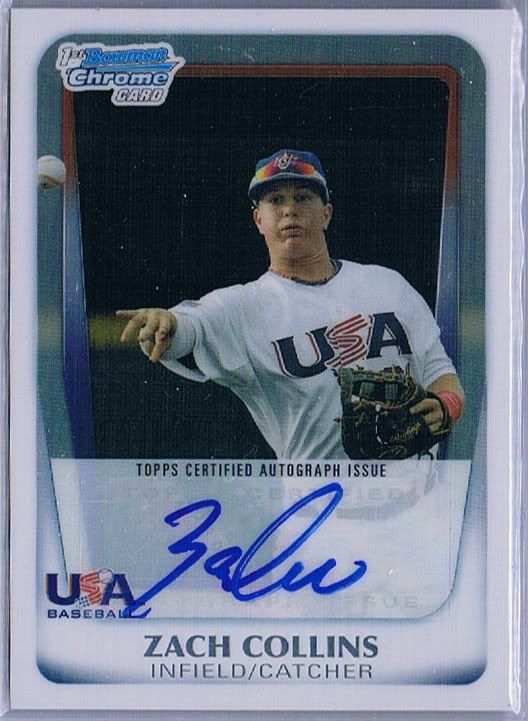
Pedofractor.
The player selection piece of the puzzle I’ll leave to the prospecting experts (which I am decidedly not). However, I did look at the backs of all of these guys’ cards and it looks like there are lots of first and second round picks represented. A few 34th round as well, but they can’t all be winners. All of the USA guys get autos too, though they’re far more limited than the prospect autos. Actually, I can’t even remember if these were bonus hits or not. They might have been. The Aflac auto below was definitely a bonus hit though.
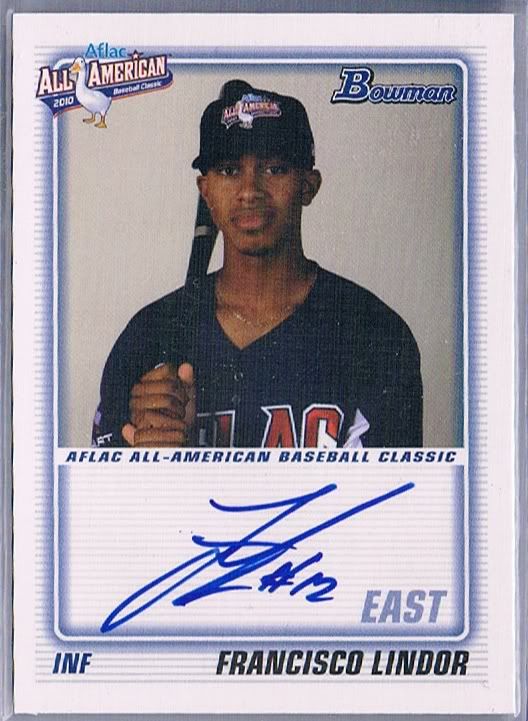
Heir to the Lindor chocolates fortune.
The AFLAC autos are still a mystery to me. Lindor has a prospect auto too, so why he’s on this “insert” auto set I do not know. Thee fall a little less than one per case think so this was a good find for us. Normally, the AFLAC autos are numbered but , due to some mistake on Topps’ part, they didn’t get around to numbering these. So they offered a free PSA grading and authentication program. I sent ours in because I’ve never sent anything to PSA and I thought our copy looked particularly pristine. I guess we’ll find out… whenever they decide to send it back. It’s been out for over two months now which probably doesn’t bode well for its value unless it grades as a 10. Oh well. Live and learn. I could gladly use a lesson in why these cards are included- I know a couple years ago they were added to get around some rules that Topps didn’t like about getting autos into sets. At any rate, both these and the USA cards remind me of this great Mr. Show sketch:
Conclusion
If I were a prospector, I would have loved every second of this break because it’s prospector heaven. But I’m not, so I only enjoyed it on a base level: ripping wax, pulling colored refractors and autographs is fun even if I don’t know any of the players and object to their very inclusion in the set. Probably an unpopular opinion (and certainly an unpopular hypocrisy since I’m the one opening a case of the stuff) as the hobby essentially revolves around First Card Autographs and the like. But there you have it.
But, from an unbiased perspective, this is a fun break that will ultimately pretty much break even for us. Had one of our refractor autos been Bubba Starling instead of a lesser player, we surely would have made money on this case. But them’s the breaks and, overall, I was happy with our return financially and enjoyment-wise.
What’s your take on Bowman Chrome and its other two sets that revolve around it? Prospect autos: good for the hobby in the long run or not? Probably questions for a post of its own but I can’t help but be curious!
Design – ****
Set Collecting – **
Parallels – ****
Hits – ***
Overall – ***1/2 out of 5

What is the diff between a blue auto or black auto(color of writing) bdpp 2011
The Blue autographs are the players’ actual signatures that come one per box. The black “auto” is actually a facsimile that’s printed onto the card instead of hand-signed. If you look closely at the two Bubba Starling scans we posted, the signature part is exactly the same because it’s not real.
I realize that I’m really late to the party, but do you by chance still have the Michael Mckenry red? I’d love to work out a trade or just buy it.
Thanks for asking, but we did end up selling it pretty early on to work towards recouping the price of the break. We do still have his blue refractor if you’d be interested in that.